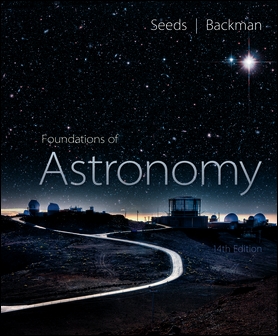書籍分類

Foundations of Astronomy 14/e
作者:Michael A. Seeds, Dana Backman
原價:NT$ 2,500
ISBN:9781337399920
版次:14
年份:2019
出版商:Cengage Learning
頁數/規格:652頁/平裝彩色
參考網頁:Foundations of Astronomy 14/e
版次:14
年份:2019
出版商:Cengage Learning
頁數/規格:652頁/平裝彩色
參考網頁:Foundations of Astronomy 14/e
內容介紹 本書特色 作者介紹
- Overview
Fascinating, engaging and extremely visual, FOUNDATIONS OF ASTRONOMY, 14th Edition, is renowned for its current coverage, reader-friendly presentation and detailed--yet clear--explanations. The authors' goals are to help you use Astronomy to understand science, and use science to answer two fundamental questions: What are we? And how do we know? Available with WebAssign, the powerful digital solution that enriches the teaching and learning experience. Complete with practice opportunities, a wealth of supplemental resources and immediate feedback, you’ll be set up to succeed.
- What's New
- Now AVAILABLE IN WEBASSIGN, both the teacher and student experience are improved -- offering more flexibility, customization and a variety of digital assets to enhance student engagement.
- New SENSE OF PROPORTION questions have been added to help students ground their understanding of relative sizes of celestial objects, distances and so on. As a complement to this, discussion of proportionality has been expanded where relevant throughout the text.
- VIRTUAL ASTRONOMY LABS with guiding narratives, astronomical data, and robust simulations are now included in a self-paced environment within WebAssign.
- Material on normal galaxies, active galaxies and black holes--Chapters 16 and 17 in the previous edition--have been combined and streamlined into a single chapter, Chapter 16. Following chapters have been renumbered as a result.
- Every chapter has been revised and updated with new text and images regarding observatories, scientific missions and new discoveries.
- KEY EQUATIONS now have numbers, titles and examples to demonstrate their use. This highlights and reinforces the equations that will be needed to solve problems in later chapters.
- The end-of-chapter SUMMARY sections have been significantly revised in all chapters with the goal of helping students focus and better navigate key concepts for review.
- Discussion Questions have been replaced with ACTIVE INQUIRY QUESTIONS, designed to engage students in deeper critical thinking.
- The authors focus strongly on the scientific method throughout the text, using astronomy to explore and explain fundamental scientific principles and processes.
- "Learning to Look" questions prompt students to answer questions based on observations of visual evidence shown in diagrams or photographs.
- "Sense of Proportion" questions gauge student understanding of relative sizes and quantities in the Universe.
- A unique art program showcases this visual science in striking style, with hallmark Concept Art providing two-page visual summaries of key concepts covered in the text. "Concept Figures" combine art and text to help students synthesize information as a unified concept. "Guided Discovery Figures" show sequential frames of art to demonstrate processes that occur over time and "H–R" diagrams are designed to help students grasp key ideas at a glance. Whenever possible, the authors bring chapter content to life with captivating photographs from the latest NASA missions.
- "How Do We Know?" boxes highlight great moments in science from various disciplines to illustrate the logical processes scientists use to learn about nature.
- "Common Misconceptions" highlight and correct popularly held misconceptions about astronomy.
- "Practicing Science" features help students review key concepts and hone critical thinking skills by considering how scientists construct logical arguments from observations, evidence, theories and natural laws. Each feature includes a thoughtfully posed science question, sample answers to illustrate scientific reasoning and sometimes a second question that allows students to construct their own argument.
- Mike Seeds was a professor of physics and astronomy at Franklin and Marshall College in Lancaster, Pennsylvania, from 1970 until his retirement in 2001. In 1989 he received F&M College’s Lindback Award for Distinguished Teaching. Mike’s love for the history of astronomy led him to create upper-level courses on archaeoastronomy and on the Copernican Revolution (“Changing Concepts of the Universe”). His research interests focused on variable stars and automation of astronomical telescopes. Mike is coauthor with Dana Backman of Horizons: Exploring the Universe, 12th edition (2012); Universe: Solar Systems, Stars, and Galaxies, 7th edition (2012); Stars and Galaxies, 8th edition (2013); The Solar System, 8th edition (2013); and ASTRO, 2nd edition (2013), all published by Cengage. He was senior consultant for creation of the 20-episode telecourse accompanying his book Horizons: Exploring the Universe.
Dana Backman taught in the physics and astronomy department at Franklin and Marshall College in Lancaster, Pennsylvania, from 1991 until 2003. He invented and taught a course titled “Life in the Universe” in F&M’s interdisciplinary Foundations program. Dana now teaches introductory Solar System astronomy at Santa Clara University and introductory astronomy, astrobiology, and cosmology courses in Stanford University’s Continuing Studies Program. His research interests focus on infrared observations of planet formation, models of debris disks around nearby stars, and evolution of the solar system’s Kuiper belt. Dana is employed by the SETI Institute in Mountain View, California, as director of education and public outreach for SOFIA (the Stratospheric Observatory for Infrared Astronomy) at NASA’s Ames Research Center. Dana is coauthor with Mike Seeds of Horizons: Exploring the Universe, 14th edition (2018); Universe: Solar Systems, Stars, and Galaxies, 7th edition (2012); Stars and Galaxies, 8th edition (2013); The Solar System, 8th edition (2013); and ASTRO, 2nd edition (2013), all published by Cengage.


